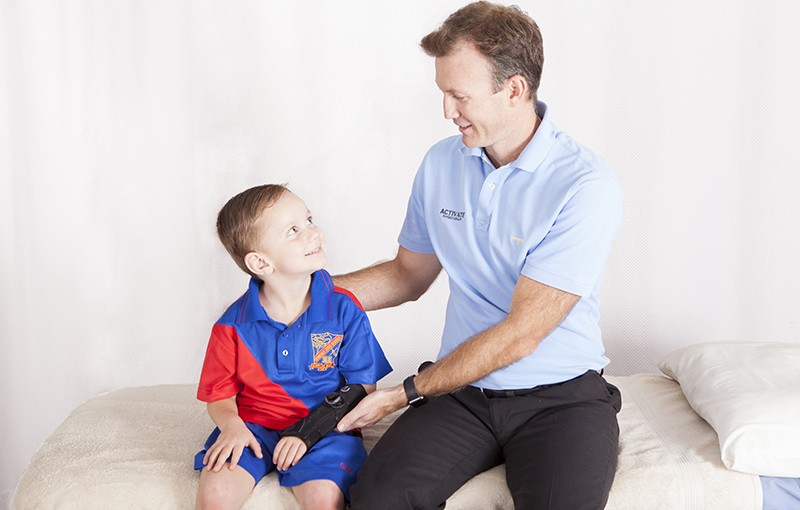Growth Plate Fracture
A growth plate fractures (or epiphyseal plate injury) is a potentially concerning injury in children and adolescents. The technical name for a growth plate is the physis, which are areas of cartilage located near the ends of bones. They are the last portion of a child’s bones to harden (ossify) and this is what makes them particularly vulnerable to fracture. The growth plate helps determine the future length and shape of the mature bone. If not treated properly, it could result in a limb that is crooked or unequal in length when compared to its opposite limb. Fortunately, serious problems are rare and with proper treatment, most growth plate fractures heal without complications.
This article will deal with growth plate injuries on a general basis and will not focus on any one part of the body.

What are the Types of Growth Plate Fracture?
To help understand growth plate fractures a classification system was created and is called the salter-harris classification. There are 5 types of growth plate injuries:
- Type 1: fracture through the growth plate so the epiphysis separates from shaft of the bone
- Type II: fracture occurs through shaft and the growth plate forming a triangular shaped fragment. This is the most common type of growth plate fracture occurring around 75% of the time.
- Type III: fracture occurs through the growth plate and the end of the bone. Due to the fracture occurring at the end of the bone this type of fracture can be quite unstable and almost always needs accurate realignment and possible surgery. Luckily it is less common happening only 8% of growth plate fractures
- Type IV: fracture goes through the shaft, growth plate and the end of the bone and affects the joint. Like type III these fractures can be quite unstable and need accurate realignment and possibly surgery.
- Type V: fracture occurs when there is a compression force to the growth plate. These types of fracture are quite uncommon and may result in the growth plate partly or completely destroyed so the bone no longer continues to grow.

What is the Prognosis with a Growth Plate Fracture?
The type I and II growth plate fracture are the most common and fortunately do well with conservative management. They are rarely associated with growth disturbance. The other 3 are less common and have higher levels of risk where the 5th type is rare but has a potential high level of growth disturbance. All types require close monitoring for management and more frequent imaging to assess the healing position and process. It is also recommended in a lot of cases where there has been a good short term healing response that follow imaging be performed at 6 months and 12 months post injury to monitor how the body has responded to an injury in this region. In high risk cases follow up is also recommended around growth plate closure ages.
For some areas of the body like the wrist that has extensive remodelling potential the risk of physeal arrest is rare in young children but the risk is higher if the child is near the end of growth.
Treatment for Growth Plate Fracture
The key to getting a good result and returning to full function is early management. Activate Physiotherapy offer same day appointments to attend their fracture clinic to ensure your fracture is managed with the best management from the start.
The treatment is specific to each person, injury type and its location in the body. The great news is that many growth plate fractures are able to be managed conservatively. The first line of treatment will be protecting the fracture site while it is healing. In most straight forward cases your fracture will be immobilised for a short period. After this you are assisted to begin a graded rehabilitation program aimed at your goals, for example returning to sport and activity. Braces/splints work by protecting your fracture by keeping it in a stable position. Your physiotherapist will advise you on the appropriate length of time specific to the nature and severity of your injury.

Our approach is unique and our physiotherapists understand the importance of integrating your rehab during the healing process and will assist you with a rehabilitation program at the various stages of your healing journey. In some higher risk cases we may also work in conjunction with a sports physician or orthopaedic surgeon.
When healing is finished your muscles will be weaker because they haven’t been used as much. Your physiotherapist can assess your strength levels and give you exercises to strengthen your muscles and get them back to normal. It is important to tell your Physiotherapist about any specific goals or sports you may have so they can make your exercises specific to your needs.
How to Make a Fracture Clinic Appointment
Making an appointment at our fracture clinic is as easy as booking online for your nearest Brisbane based Activate Physiotherapy clinic in Stafford or Gumdale.
No Xray? No problem!
We can arrange bulk-billed xrays to confirm diagnosis and monitor healing.
Need your cast removed?
We can help with that too! We are able to remove backslabs and full plaster or polyester casts
